British Rail
British Railways (BR), which from 1965 traded as British Rail, was the state-owned company that operated most of the overground rail transport in Great Britain between 1948 and 1997. It was formed from the nationalisation of the "Big Four" British railway companies and lasted until the gradual privatisation of British Rail, in stages between 1994 and 1997. Originally a trading brand of the Railway Executive of the British Transport Commission, it became an independent statutory corporation in 1962 designated as the British Railways Board.[1]
| State-owned enterprise | |
| Industry | Railway transport, logistics, shipping and rolling stock manufacturer |
| Fate | Privatised |
| Predecessor |
and 55 others |
| Successor |
|
| Founded | 1 January 1948 |
| Defunct | 1 February 2001 |
| Headquarters | , United Kingdom |
Area served | Great Britain |
Key people | Member of the Railway Executive in charge of Mechanical and Electrical Engineering Robert Riddles, Chairman of the British Railways Board Peter Parker, General Manager of Eastern Region Gerry Fiennes |
| Products | Rail transport, cargo transport, services |
| Owner | HM Government (100%) |
| Parent | British Transport Commission (1948–1962) British Railways Board (1962–2001) |
| Divisions | 1948: |
| Subsidiaries | |
The period of nationalisation saw sweeping changes in the national railway network. A process of dieselisation and electrification took place, and by 1968 steam locomotion had been entirely replaced by diesel and electric traction, except for the Vale of Rheidol Railway (a narrow-gauge tourist line). Passengers replaced freight as the main source of business, and one third of the network was closed by the Beeching Axe of the 1960s in an effort to reduce rail subsidies.
On privatisation, responsibility for track, signalling and stations was transferred to Railtrack (which was later brought under public control as Network Rail) and that for trains to the train operating companies.
The British Rail "double arrow" logo is formed of two interlocked arrows showing the direction of travel on a double track railway and was nicknamed "the arrow of indecision".[2][3] It is now employed as a generic symbol on street signs in Great Britain denoting railway stations, and as part of the Rail Delivery Group's (RDG) jointly managed National Rail brand is still printed on railway tickets.[4]
History
.jpg)
Nationalisation in 1948
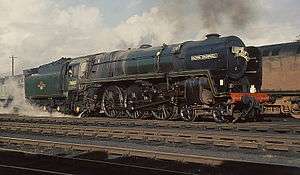
The rail transport system in Great Britain developed during the 19th century. After the grouping of 1923 under the Railways Act 1921, there were four large railway companies, each dominating its own geographic area: the Great Western Railway (GWR), the London, Midland and Scottish Railway (LMS), the London and North Eastern Railway (LNER) and the Southern Railway (SR). During World War I the railways were under state control, which continued until 1921. Complete nationalisation had been considered, and the Railways Act 1921[5] is sometimes considered as a precursor to that, but the concept was rejected. Nationalisation was subsequently carried out after World War II, under the Transport Act 1947. This Act made provision for the nationalisation of the network, as part of a policy of nationalising public services by Clement Attlee's Labour Government. British Railways came into existence as the business name of the Railway Executive of the British Transport Commission (BTC) on 1 January 1948 when it took over the assets of the Big Four.[6]
There were also joint railways between the Big Four and a few light railways to consider (see list of constituents of British Railways). Excluded from nationalisation were industrial lines like the Oxfordshire Ironstone Railway. The London Underground – publicly owned since 1933 – was also nationalised, becoming the London Transport Executive of the British Transport Commission. The Bicester Military Railway was already run by the government. The electric Liverpool Overhead Railway was also excluded from nationalisation.[7]
The Railway Executive was conscious that some lines on the (then very dense) network were unprofitable and hard to justify socially, and a programme of closures began almost immediately after nationalisation. However, the general financial position of BR became gradually poorer, until an operating loss was recorded in 1955. The Executive itself had been abolished in 1953 by the Conservative government, and control of BR transferred to the parent Commission. Other changes to the British Transport Commission at the same time included the return of road haulage to the private sector.
Regions
British Railways was divided into regions which were initially based on the areas the former Big Four operated in; later, several lines were transferred between regions. Notably, these included the former Great Central lines from the Eastern Region to the London Midland Region, and the West of England Main Line from the Southern Region to Western Region
- Southern Region: former Southern Railway lines.
- Western Region: former Great Western Railway lines.
- London Midland Region: former London Midland and Scottish Railway lines in England and Wales.
- Eastern Region: former London and North Eastern Railway lines south of York.
- North Eastern Region: former London and North Eastern Railway lines in England north of York.
- Scottish Region: all lines, regardless of original company, in Scotland.
The North Eastern Region was merged with the Eastern Region in 1967. In 1982, the regions were abolished and replaced by "business sectors", a process known as sectorisation.
The Anglia Region was created in late 1987, its first General Manager being John Edmonds, who began his appointment on 19 October 1987. Full separation from the Eastern Region – apart from engineering design needs – occurred on 29 April 1988. It handled the services from Fenchurch Street and Liverpool Street, its western boundary being Hertford East, Meldreth and Whittlesea.[8][9]
1955 Modernisation Plan
.jpg)
The report, latterly known as the "Modernisation Plan",[10] was published in January 1955. It was intended to bring the railway system into the 20th century. A government White Paper produced in 1956 stated that modernisation would help eliminate BR's financial deficit by 1962, but the figures in both this and the original plan were produced for political reasons and not based on detailed analysis.[11] The aim was to increase speed, reliability, safety, and line capacity through a series of measures that would make services more attractive to passengers and freight operators, thus recovering traffic lost to the roads. Important areas included:
- Electrification of principal main lines, in the Eastern Region, Kent, Birmingham to Liverpool/Manchester and Central Scotland
- Large-scale dieselisation to replace steam locomotives
- New passenger and freight rolling stock
- Resignalling and track renewals
- Modern marshalling yards
- The closure of an unspecified, but relatively small, number of lines
The government appeared to endorse the 1955 programme (costing £1.2 billion), but did so largely for political reasons.[11] This included the withdrawal of steam traction and its replacement by diesel (and some electric) locomotives. Not all the modernisations would be effective at reducing costs. The dieselisation programme gave contracts primarily to British suppliers, who had limited experience of diesel locomotive manufacture, and rushed commissioning based on an expectation of rapid electrification; this resulted in numbers of locomotives with poor designs, and a lack of standardisation.[12] At the same time, containerised freight was being developed.[12] The marshalling yard building programme was a failure, being based on a belief in the continued viability of wagon-load traffic in the face of increasingly effective road competition, and lacking effective forward planning or realistic assessments of future freight.[12] A 2002 documentary broadcast on BBC Radio Four blamed the 1950s decisions for the "beleaguered" condition of the railway system at that time.[13]
The Beeching reports
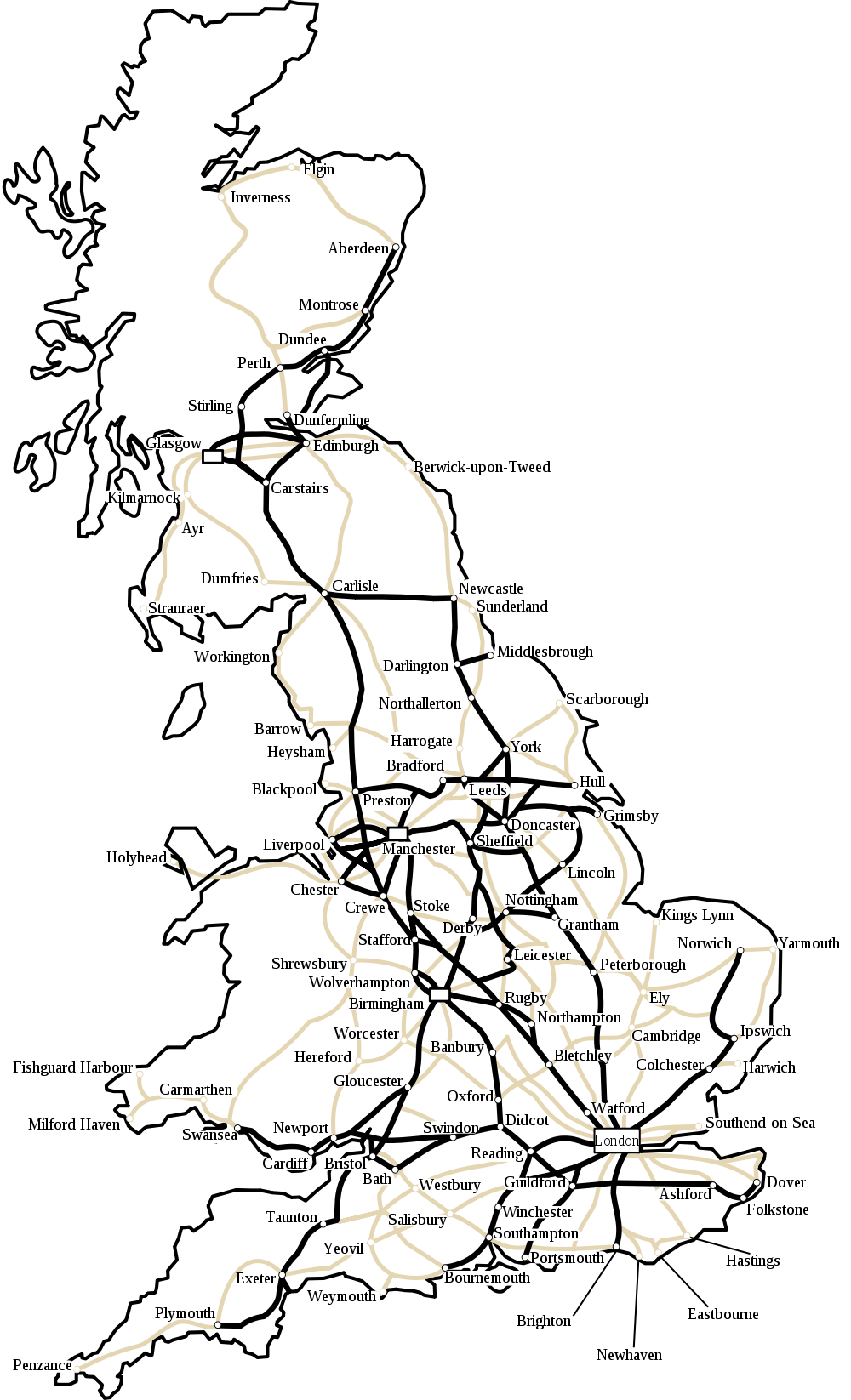
During the late 1950s, railway finances continued to worsen, whilst passenger numbers grew after restoring many services reduced during the war, and in 1959 the government stepped in, limiting the amount the BTC could spend without ministerial authority. A White Paper proposing reorganisation was published in the following year, and a new structure was brought into effect by the Transport Act 1962.[14] This abolished the commission and replaced it by several separate boards. These included a British Railways Board, which took over on 1 January 1963.[15]
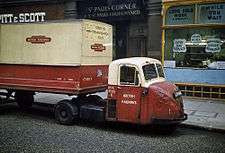
Following semi-secret discussions on railway finances by the government-appointed Stedeford Committee in 1961, one of its members, Dr Richard Beeching, was offered the post of chairing the BTC while it lasted, and then becoming the first Chairman of the British Railways Board.[16]
A major traffic census in April 1961, which lasted one week, was used in the compilation of a report on the future of the network. This report—The Reshaping of British Railways—was published by the BRB in March 1963.[17][18] The proposals, which became known as the "Beeching Axe", were dramatic. A third of all passenger services and more than 4,000 of the 7,000 stations would close. Beeching, who is thought to have been the author of most of the report, set out some dire figures. One third of the network was carrying just 1% of the traffic. Of the 18,000 passenger coaches, 6,000 were said to be used only 18 times a year or less. Although maintaining them cost between £3m and £4m a year, they earned only about £0.5m.[19]
Most of the closures were carried out between 1963 and 1970 (including some which were not listed in the report) while other suggested closures were not carried out. The closures were heavily criticised at the time.[20] A small number of stations and lines closed under the Beeching programme have been reopened, with further reopenings proposed.[21]
A second Beeching report, "The Development of the Major Trunk Routes", followed in 1965.[22] This did not recommend closures as such, but outlined a "network for development". The fate of the rest of the network was not discussed in the report.
Post-Beeching
The basis for calculating passenger fares changed in 1964. In future, fares on some routes—such as rural, holiday and commuter services—would be set at a higher level than on other routes; previously, fares had been calculated using a simple rate for the distance travelled, which at the time was 3d per mile second class, and 4½d per mile first class[23] (equivalent to £0.26 and £0.38 respectively, in 2019[24]).
Passenger levels decreased steadily from 1962 to the late 1970s,[25] and reached a low in 1982.[26] Network improvements included completing electrification of the Great Eastern Main Line from London to Norwich between 1976 and 1986 and the East Coast Main Line from London to Edinburgh between 1985 and 1990. A main line route closure during this period of relative network stability was the 1500 V DC-electrified Woodhead Line between Manchester and Sheffield: passenger service ceased in 1970 and goods in 1981.
The 1980s and 1990s saw the closure of some railways which had survived the Beeching Axe a generation earlier, but which had seen passenger services withdrawn. This included the bulk of the Chester and Connah's Quay Railway in 1992, the Brierley Hill to Walsall section of the South Staffordshire Line in 1993, while the Birmingham to Wolverhampton section of the Great Western Railway was closed in three phases between 1972 and 1992.
A further British Rail report, from a committee chaired by Sir David Serpell, was published in 1983. The Serpell Report made no recommendations as such, but did set out various options for the network including, at their most extreme, a skeletal system of less than 2000 route km. This report was not welcomed, and the government decided to quietly leave it on the shelf. Meanwhile, BR was gradually reorganised, with the regional structure finally being abolished and replaced with business-led sectors. This process, known as "sectorisation", led to far greater customer focus, but was cut short in 1994 with the splitting up of BR for privatisation.

Upon sectorisation in 1982, three passenger sectors were created: InterCity, operating principal express services; London & South East (renamed Network SouthEast in 1986) operating commuter services in the London area; and Provincial (renamed Regional Railways in 1989) responsible for all other passenger services.[27] In the metropolitan counties local services were managed by the Passenger Transport Executives. Provincial was the most subsidised (per passenger km) of the three sectors; upon formation, its costs were four times its revenue.[27] During the 1980s British Rail ran the Rail Riders membership club aimed at 5- to 15-year-olds.
Because British Railways was such a large operation, running not just railways but also ferries, steamships and hotels, it has been considered difficult to analyse the effects of nationalisation.[28]
Prices rose quickly in this period, rising 108% in real terms from 1979 to 1994, as prices rose by 262% but RPI only increased by 154% in the same time.[29]
Branding
Pre-1960s
Following nationalisation in 1948, British Railways began to adapt the corporate liveries on the rolling stock it had inherited from its predecessor railway companies. Initially, an express blue (followed by GWR-style Brunswick green in 1952) was used on passenger locomotives, and LNWR-style lined black for mixed-traffic locomotives, but later green was more widely adopted.[30][31]
Development of a corporate identity for the organisation was hampered by the competing ambitions of the British Transport Commission and the Railway Executive. The Executive attempted to introduce a modern an Art Deco-style curved logo which could also serve as the standard for station signage totems. BR eventually adopted the common branding of the BTC as its first corporate logo, a lion astride a spoked wheel, designed for the BTC by Cecil Thomas; on the bar overlaid across the wheel, the BTC's name was replaced with the words "British Railways". This logo, nicknamed the "Cycling Lion", was applied from 1948 to 1956 to the sides of locomotives, while the oval style was adopted for station signs across Great Britain, each coloured according to the appropriate BR region, using the Gill Sans font first adopted by LNER in 1923.[32]
In 1956, the BTC was granted a heraldic achievement by the College of Arms and the Lord Lyon, and then BTC chairman Brian Robertson wanted a grander logo for the railways. BR's second corporate logo (1956–1965), designed in consultation with Charles Franklyn, adapted the original, depicting a rampant lion emerging from a heraldic crown and holding a spoked wheel, all enclosed in a roundel with the "British Railways" name displayed across a bar on either side. This emblem soon acquired the nickname of the "Ferret and Dartboard". A variant of the logo with the name in a circle was also used on locomotives.[32]
.jpg) The earlier lion crest on BR locomotive No.12589
The earlier lion crest on BR locomotive No.12589.jpg) The later lion crest on BR locomotive No. 92220 Evening Star
The later lion crest on BR locomotive No. 92220 Evening Star Liverpool Central station sign using the art deco totem
Liverpool Central station sign using the art deco totem
1960s
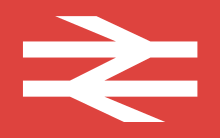
The zeal for modernisation in the Beeching era drove the next rebranding exercise, and BR management wished to divest the organisation of anachronistic, heraldic motifs and develop a corporate identity to rival that of London Transport. BR's design panel set up a working party led by Milner Gray of the Design Research Unit. They drew up a Corporate Identity Manual which established a coherent brand and design standard for the whole organisation, specifying Rail Blue and pearl grey as the standard colour scheme for all rolling stock; Rail Alphabet as the standard corporate typeface, designed by Jock Kinneir and Margaret Calvert; and introducing the now-iconic Corporate Identity Symbol of the "Double Arrow" logo. Designed by Gerald Barney (also of the DRU), this arrow device was formed of two interlocked arrows across two parallel lines, symbolising a double track railway. It was likened to a bolt of lightning or barbed wire, and also acquired a nickname: "the arrow of indecision". A mirror image of the double arrow was used on the port side of BR-owned Sealink ferry funnels. The new BR corporate identity and Double Arrow were rolled out in 1965, and the brand name of the organisation was truncated to "British Rail".[32][31]
Post-1960s
The uniformity of BR branding continued until the process of sectorisation was introduced in the 1980s. Certain BR operations such as Inter-City, Network SouthEast, Regional Railways or Railfreight began to adopt their own identities, introducing logos and colour schemes which were essentially variants of the British Rail brand. Eventually, as sectorisation developed into a prelude to privatisation, the unified British Rail brand disappeared, with the notable exception of the Double Arrow symbol, which has survived to this day and serves as a generic trademark to denote railway services across Great Britain.[32] The BR Corporate Identity Manual is noted as a piece of British design history and there are plans for it to be re-published.[33]
Finances
Despite its nationalisation in 1947 "as one of the 'commanding heights' of the economy",[34] according to some sources British Rail was not profitable for most (if not all)[35] of its history.[36] Newspapers reported that as recently as the 1990s, public rail subsidy was counted as profit;[37] as early as 1961, British Railways were losing £300,000 a day.[38]
Although the company was considered the sole public-transport option in many rural areas, the Beeching cuts made buses the only public transport available in some rural areas.[39] Despite increases in traffic congestion and road fuel prices beginning to rise in the 1990s, British Rail remained unprofitable. Following sectorisation, InterCity became profitable. InterCity became one of Britain's top 150 companies, providing city centre to city centre travel across the nation from Aberdeen and Inverness in the north, to Poole and Penzance in the south.[40]
Investment
In 1979 the incoming Conservative Government led by Margaret Thatcher was viewed as anti-railway, and did not want to commit public money to the railways. However, British Rail was allowed to spend its own money with government approval. This led to a number of electrification projects being given the go-ahead, including the East Coast Main Line, the spur from Doncaster to Leeds, and the lines in East Anglia out of London Liverpool Street to Norwich and King's Lynn. The list with approximate completion dates includes:
- St Pancras – Bedford 1981–83
- Rock Ferry – Hooton 1985
- Hitchin – Leeds 1985–88
- Colchester – Norwich 1986
- Bishops Stortford – Cambridge 1987
- Watford Junction – St Albans Abbey 1988
- Royston – Cambridge 1988
- Snow Hill Tunnel as part of Thameslink project 1988
- Doncaster – York 1989
- Airdrie – Drumgelloch 1989
- York – Edinburgh Waverley (and the spur to North Berwick) 1991
- Carstairs – Edinburgh Waverley 1991
- Cambridge – King's Lynn 1992
- Hooton – Ellesmere Port and Chester 1993–94
- London Paddington – Heathrow Airport 1993–98
- Leeds City and Bradford Forster Square – Skipton and Ilkley 1994
In the Southwest, the line from Bournemouth to Weymouth was electrified along with other infill 750 V DC 3rd rail electrification in the south. In 1988, the line to Aberdare was reopened. A British Rail advertisement ("Britain's Railway", directed by Hugh Hudson) featured some of the best known railway structures in Britain, including the Forth Rail Bridge, Royal Albert Bridge, Glenfinnan Viaduct and London Paddington station.[41] London Liverpool Street station was rebuilt, opened by Queen Elizabeth II, and a new station was constructed at Stansted Airport in 1991. The following year, the Maesteg Line was reopened. In 1988, the Windsor Link Line, Greater Manchester was constructed and has proven to be an important piece of infrastructure.
Privatisation
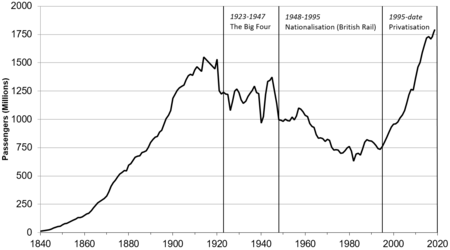

In 1989, the narrow-gauge Vale of Rheidol Railway was preserved, becoming the first part of British Rail to be privatised. Between 1994 and 1997, British Rail was privatised.[42] Ownership of the track and infrastructure passed to Railtrack on 1 April 1994. Passenger operations were later franchised to 25 private-sector operators and the freight services were sold to six companies, five of whom were owned by the same buyer.[43]
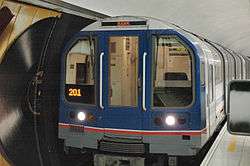
The Waterloo & City line, part of BR Network SouthEast, was not included in the privatisation and was transferred to London Underground in April 1994. The remaining obligations of British Rail were transferred to BRB (Residuary) Limited.
The privatisation, proposed by the Conservative government in 1992, was opposed by the Labour Party and the rail unions. Although Labour initially proposed to reverse privatisation,[44] the New Labour manifesto of 1997 instead opposed Conservative plans to privatise the London Underground.[45] Rail unions have historically opposed privatisation, but former Associated Society of Locomotive Engineers and Firemen general secretary Lew Adams moved to work for Virgin Trains, and said on a 2004 radio phone-in programme: "All the time it was in the public sector, all we got were cuts, cuts, cuts. And today there are more members in the trade union, more train drivers, and more trains running. The reality is that it worked, we’ve protected jobs, and we got more jobs."[46][47]
Accidents and incidents
Network

The former BR network, with the trunk routes of the West Coast Main Line, East Coast Main Line, Great Western Main Line, Great Eastern Main Line and Midland Main Line, and other lines.
Preserved lines
The narrow-gauge Vale of Rheidol Railway in Ceredigion, Wales became part of British Railways at nationalisation. Although built as a working railway, in 1948 the line was principally a tourist attraction. British Rail operated the line using steam locomotives, long after the withdrawal of standard-gauge steam. The line's three steam locomotives were the only ones to receive TOPS serial numbers and be painted in BR Rail Blue livery with the double arrow logo. The Vale of Rheidol Railway was privatised in 1989 and continues to operate as a private heritage railway.
Other preserved lines, or heritage railways, have reopened lines previously closed by British Rail. These range from picturesque rural branch lines like the Keighley and Worth Valley Railway to sections of mainline such as the Great Central Railway. Many have links to the National Rail network, both at station interchanges, for example the Severn Valley Railway between Kidderminster and Kidderminster Town, and physical rail connections like the Watercress Line at Alton.
Although most are operated solely as leisure amenities some also provide educational resources, and a few have ambitions to restore commercial services over routes abandoned by the nationalised industry.
Marine services
Ships
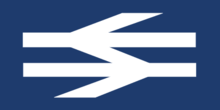
British Railways operated ships from its formation in 1948 on several routes. Many ships were acquired on nationalisation, and others were built for operation by British Railways or its later subsidiary, Sealink. Those ships capable of carrying rail vehicles were classed under TOPS as Class 99.
Sealink
_-_geograph.org.uk_-_1158519.jpg)
Sealink was originally the brand name for the ferry services of British Rail in the United Kingdom and Ireland. Services to France, Belgium, and the Netherlands were run by Sealink UK as part of the Sealink consortium which also used ferries owned by French national railways (SNCF), the Belgian Maritime Transport Authority Regie voor Maritiem Transport/Regie des transports maritimes (RMT/RTM) and the Dutch Stoomvaart Maatschappij Zeeland (Zeeland Steamship Company).
Historically, the shipping services were exclusively an extension of the railways across the English Channel and the Irish Sea in order to provide through, integrated services to Europe and Ireland. As international travel became more popular in the late 1960s and before air travel became generally affordable, the responsibility for shipping services was taken away from the British Rail Regions and in 1969 centralised in a new division – British Rail Shipping and International Services Division.
With the advent of car ferry services, the old passenger-only ferries were gradually replaced by roll-on/roll-off ships, catering for motorists and rail passengers as well as road freight. However, given that there was now competition in the form of other ferry companies offering crossings to motorists, it became necessary to market the services in a normal business fashion (as opposed to the previous almost monopolistic situation). Thus, with the other partners mentioned above, the brand name Sealink was introduced for the consortium.[48]
In the late 1960s, as demand for international rail travel declined and the shipping business became almost exclusively dependent on passenger and freight vehicle traffic, the ferry business was incorporated as Sealink UK Limited on 1 January 1979,[49][50] a wholly owned subsidiary of the British Railways Board, but still part of the Sealink consortium. In 1979, Sealink acquired Manx Line which offered services to the Isle of Man from Heysham.
On 27 July 1984 the UK Government sold Sealink UK Limited to Sea Containers for £66m[51] and the company was renamed Sealink British Ferries. The sale excluded the operations of Hoverspeed, the Isle of Wight services and the share in the Isle of Man Steam Packet Company, as well as the Port of Heysham. In 1996, the Sealink name disappeared when the UK services, by then owned by Stena,[49] were re-branded as Stena Line. The agreement with the SNCF on the Dover to Calais route also ended at this time and the French-run Sealink services were rebranded as SeaFrance.
Hovercraft
The joint hovercraft services of British Rail (under British Rail Hovercraft Limited) in association with the French SNCF.[52] British Rail Hovercraft Limited was established in 1965, under authority given to it by the British Railways Act 1967 and started its first service in 1966. Seaspeed started cross-Channel services from Dover, England to Calais and Boulogne-sur-Mer, France using SR-N4 hovercraft in August 1968.
British Rail Engineering Limited
Incorporated on 31 October 1969, British Rail Engineering Limited (BREL) was a wholly owned railway systems engineering subsidiary of the British Railways Board. Created through the Transport Act 1968, to manage BR's thirteen workshops, it replaced the British Rail Workshops Division which had existed since 1948. The works managed by BREL were Ashford, Crewe, Derby Locomotive Works, Derby Litchurch Lane, Doncaster, Eastleigh, Glasgow (formerly St Rollox), Horwich Foundry, Shildon, Swindon, Temple Mills, Wolverton, and York.[53] BREL began trading in 1970 under managing director A.E. Robson. In 1989 the design and construction of trains in the UK was privatised, and BREL ceased to exist.[54]
Mark 2 carriages
A family of railway carriages, designed and built by British Rail workshops (from 1969 British Rail Engineering Limited) between 1964 and 1975. They were of steel construction. Many remain in service to this day.
Advanced Passenger Train
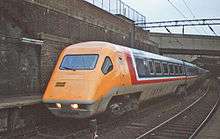
In the 1970s, British Rail developed tilting train technology in the Advanced Passenger Train; there had been earlier experiments and prototypes in other countries, notably Italy.[55] The objective of the tilt was to minimise the discomfort to passengers caused by taking the curves of the West Coast Main Line at high speed. The APT also had hydrokinetic brakes, which enabled the train to stop from 150 mph within existing signal spacings.[56]
The introduction into service of the Advanced Passenger Train was to be a three-stage project. Phase 1, the development of an experimental APT (APT-E), was completed. This used a gas turbine-electric locomotive, the only multiple unit so powered that was used by British Rail. It was formed of two power cars (numbers PC1 and PC2), initially with nothing between them and later, two trailer cars (TC1 and TC2).[57] The cars were made of aluminium to reduce the weight of the unit and were articulated. The gas turbine was dropped from development, due to excessive noise and the high fuel costs of the late 1970s.[58] The APT-E first ran on 25 July 1971. The train drivers' union, ASLEF, black-listed the train due to its use of a single driver. The train was moved to Derby (with the aid of a locomotive inspector). This triggered a one-day strike by ASLEF that cost BR more than the research budget for the entire year.[59]
Phase 2, the introduction of three prototype trains (APT-P) into revenue service on the Glasgow – London Euston route, did occur. Originally, there were to have been eight APT-P sets running, with minimal differences between them and the main fleet. However, financial constraints lead to only three being authorised, after two years of discussion by the British Railways Board. The cost was split equally between the Board and the Ministry of Transport. After these delays, considerable pressure grew to put the APT-P into revenue-service before they were fully ready. This inevitably lead to high-profile failures as a result of technical problems.[59]
These failures led to the trains being withdrawn from service while the problems were ironed out. However, by this time, managerial and political support had evaporated. Consequently, phase 3, the introduction of the Squadron fleet (APT-S), did not occur, and the project was ended in 1982.
Although the APT never properly entered service, the experience gained enabled the construction of other high-speed trains. The APT powercar technology was imported without the tilt into the design of the Class 91 locomotives, and the tilting technology was incorporated into Italian State Railway's Pendolino trains, which first entered service in 1987.
InterCity 125
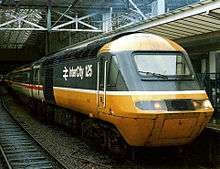
The InterCity 125 (originally Inter-City 125,[60] or High Speed Train) is a diesel-powered passenger train built by British Rail Engineering Limited between 1975 and 1982. Widely credited with saving British Rail, it is usually called HST.[61] Each set is made up of two Class 43 power cars, one at each end and six to nine Mark 3 carriages. The name is derived from its top operational speed of 125 mph (201 km/h). Initially the sets were classified as Classes 253 and 254.
The prototype InterCity 125 (power cars 43000 and 43001) set the world speed record for diesel traction at 143.2 mph (230.5 km/h) on 12 June 1973.[62]
Successor companies
Under the process of British Rail's privatisation, operations were split into more than 100 companies. The ownership and operation of the infrastructure of the railway system was taken over by Railtrack. The Telecomms infrastructure and British Rail Telecommunications was sold to Racal, which in turn was sold to Global Crossing and merged with Thales Group. The rolling stock was transferred to three private rolling stock companies (ROSCOs). Passenger services were divided into 25 operating companies, which were let on a franchise basis for a set period, whilst goods services were sold off completely. Dozens of smaller engineering and maintenance companies were also created and sold off.
British Rail's passenger services came to an end upon the franchising of ScotRail; the final train that the company operated was a Railfreight Distribution goods train in autumn 1997. The British Railways Board continued in existence as a corporation until early 2001, when it was replaced with the Strategic Rail Authority.
Since privatisation, the structure of the rail industry and number of companies has changed several times as franchises have been re-let and the areas covered by franchises restructured. Franchise-based companies that took over passenger rail services include:
- Midland Mainline—superseded in 2007 by East Midlands Trains and now is East Midlands Railway.
- Great North Eastern Railway—superseded in 2007 by National Express East Coast, brought back into public ownership with the creation of the new government-controlled East Coast operator; the East Coast franchise was transferred to Virgin Trains East Coast in 2015 who had their franchise terminated five years early in 2018, and the East Coast Mainline was brought back into public ownership with the creation of the new government-controlled London North Eastern Railway
- Virgin Trains West Coast—superseded in 2019 by Avanti West Coast
- Virgin CrossCountry—superseded in 2007 by CrossCountry
- ScotRail—operated by National Express, superseded in 2004 by First ScotRail; control of the franchise has since passed to Abellio ScotRail
- Great Western Trains—became First Great Western in 2008, renamed to Great Western Railway in 2015
- Wales & West—became Wessex Trains and Wales & Borders (including the Cardiff Railway Company services operated as Valley Lines) in 2001, after being split into two separate franchises, and now run by Great Western Railway and Transport for Wales
- Arriva Trains Northern—originally Northern Spirit, succeeded in 2004 by First TransPennine Express and Northern Rail
- First North Western—originally North Western Trains, succeeded in 2004 by First TransPennine Express and Northern Rail
- Anglia Railways, Great Eastern (later First Great Eastern), and the West Anglia section of WAGN were merged to become One, later renamed National Express East Anglia, superseded in 2012 by Abellio Greater Anglia, now known as Greater Anglia
- Thameslink—succeeded by First Capital Connect in 2006, combined at the same time with West Anglia Great Northern to form the Thameslink Great Northern franchise; succeeded by Govia Thameslink Railway in 2014, augmented by South Central and Gatwick Express to form the Thameslink, Southern and Great Northern franchise in 2015
- LTS (London, Tilbury & Southend)—rebranded as c2c in 2000
- Connex South Eastern became South Eastern Trains, then Southeastern
- Connex South Central became South Central and later renamed Southern
- Merseyrail Electrics superseded by Arriva Trains Merseyside and now Merseyrail
- South West Trains then South Western Railway operated by FirstGroup and MTR Corporation, in 2017
- Central Trains—divided in 2007 between London Midland, CrossCountry and East Midlands Trains
- London Underground for the short underground Waterloo & City line
- Silverlink—divided in 2007 between London Overground and London Midland
Future
Since privatisation, many groups have campaigned for the renationalisation of British Rail, most notably 'Bring Back British Rail'.[63] Various interested parties also have views on the privatisation of British Rail.

The renationalisation of the railways of Britain continues to have popular support. Polls in 2012 and 2013 showed 70% and 66% support for renationalisation, respectively.[64][65]
Due to rail franchises lasting sometimes over a decade, full renationalisation would take years unless compensation was paid to terminate contracts early.
When the infrastructure-owning company Railtrack ceased trading in 2002, the Labour government set up the not-for-dividend company Network Rail to take over the duties rather than renationalise this part of the network. However, in September 2014, Network Rail was reclassified as a central government body, adding around £34 billion to public sector net debt. This reclassification had been requested by the Office for Budget Responsibility to comply with pan-European accounting standard ESA10.[66]
The Green party has committed to bringing the railways 'back into public ownership' and has maintained this impetus when other parties argued to maintain the status quo. In 2016, Green MP, Caroline Lucas, put forward a Bill that would have seen the rail network fall back into public ownership step by step, as franchises come up for expiry.[67]
Under Jeremy Corbyn, the Labour Party pledged to gradually renationalise British Rail franchises if elected, as and when their private contracts expire, creating a "People's Railway".[68] In a pledge during his successful leadership campaign to succeed Corbyn, Keir Starmer said that renationalising rail would remain Labour policy under his leadership.[69]
Parodies
In 1989, the ITV Sketch Show Spitting Image parodied Hudson's 1988 British Rail, Britain's Railway advert on the plans of the then Conservative British Government to privatise the railways featuring many of the show's puppets (including the show's portrayal of former Prime Minister Margaret Thatcher), numerous BR trains and landmarks and even a cardboard cutout of Thomas the Tank Engine.[70]
See also
Divisions, brands and liveries
Classification and numbering schemes
Rolling stock
References
- Jackson, Tanya (2013). "6: In Search of an Identity". British Railways: The Nation's Railway. Stroud: The History Press. ISBN 978-0-7524-9742-6. Retrieved 11 September 2015.CS1 maint: ref=harv (link)
- Height, Frank; Cresswell, Roy (1979). Design for Passenger Transport. Pergamon. p. 118. ISBN 978-1-4831-5309-4. Retrieved 11 September 2015.CS1 maint: ref=harv (link)
- s.1 Transport Act 1962
- "The Arrow of Indecision". madebysix.wordpress.com. Archived from the original on 27 April 2017. Retrieved 26 April 2017.
- Shannon, Paul. "Blue Diesel Days". Ian Allan Publishing. Archived from the original on 1 December 2008. Retrieved 16 November 2008.
- Her Majesty's Government (2002). "The Traffic Signs Regulations and General Directions 2002 (SI 2002:3113)". Archived from the original on 19 April 2009. Retrieved 27 March 2009.
- "The State and the Railways". Parliamentary Debates (Hansard). Hansard. 3 August 1920. col. 711–713. Archived from the original on 19 July 2009. Retrieved 14 March 2019.
- Her Majesty's Government (1947). "Transport Act 1947". The Railways Archive. (originally published by Her Majesty's Stationery Office). Archived from the original on 25 March 2012. Retrieved 25 November 2006.
- "The Liverpool Overhead Railway was legendary – but is it worth rebuilding? | CityMetric". www.citymetric.com. Archived from the original on 26 April 2018. Retrieved 25 April 2018.
- Slater, John, ed. (December 1987). "Anglia Region created". Railway Magazine. Cheam: Prospect Magazines. 133 (1040): 758. ISSN 0033-8923.
- Slater, John, ed. (July 1988). "Anglia takes over". Railway Magazine. Cheam: Prospect Magazines. 134 (1047): 426. ISSN 0033-8923.
- British Transport Commission (1954). "Modernisation and Re-Equipment of British Rail". The Railways Archive. (Originally published by the British Transport Commission). Archived from the original on 31 October 2006. Retrieved 25 November 2006.
- Loft, Charles (2013) Last Trains – Dr Beeching and the Death of Rural England ISBN 9781849545006
- Terence Richard Gourvish; N. Blake (1986). British Railways, 1948–73: a business history. Cambridge University Press. pp. 286–290.
- "Bad railways? Blame it on the 1950s". BBC News. 16 May 2002. Archived from the original on 25 September 2018. Retrieved 25 September 2018.
- Her Majesty's Government (1962). "Transport Act 1962". The Railways Archive. (originally published by Her Majesty's Stationery Office). Archived from the original on 19 August 2007. Retrieved 25 November 2006.
- "nationalarchives.gov.uk". Archived from the original on 17 March 2018. Retrieved 17 March 2018.
- "Back to Beeching" Archived 3 October 2009 at the Wayback Machine, BBC Radio 4, 27 February 2010
- British Transport Commission (1963). "The Reshaping of British Railways – Part 1: Report". The Railways Archive. (originally published by Her Majesty's Stationery Office). Archived from the original on 19 October 2010. Retrieved 25 November 2006.
- British Transport Commission (1963). "The Reshaping of British Railways—Part 2: Maps". The Railways Archive. (originally published by Her Majesty's Stationery Office). Archived from the original on 26 October 2006. Retrieved 25 November 2006.
- Richard Beeching "The Reshaping of British Railways", p.15
- "The Economics and Social Aspects of the Beeching Plan" Archived 5 June 2011 at the Wayback Machine—Lord Stoneham, House of Lords, 1963
- "Move to reinstate lost rail lines" Archived 17 June 2009 at the Wayback Machine, BBC, 15 June 2009
- "The Development Of The Major Railway Trunk Routes", The Railways Archive, British Railways Board, February 1965, archived from the original on 18 April 2012, retrieved 27 March 2012
- Cooke, B.W.C., ed. (July 1964). "Notes and News: New fares structure". Railway Magazine. Westminster: Tothill Press. 110 (759): 592.
- UK Retail Price Index inflation figures are based on data from Clark, Gregory (2017). "The Annual RPI and Average Earnings for Britain, 1209 to Present (New Series)". MeasuringWorth. Retrieved 2 February 2020.
- The UK Department for Transport (DfT), specifically Table 6.1 from Transport Statistics Great Britain 2006 Archived 8 September 2008 at the Wayback Machine (4 MB PDF file)
- "Archived copy" (PDF). Archived from the original on 5 January 2016. Retrieved 13 August 2017.CS1 maint: archived copy as title (link) CS1 maint: BOT: original-url status unknown (link)
- Thomas, David St John; Whitehouse, Patrick (1990). BR in the Eighties. Newton Abbot: David & Charles. ISBN 0-7153-9854-7.
- Boocokc, Colin. Spotlight on BR: British Railways 1948–1998 Success or Disaster?. ISBN 978-0-906899-98-4.
- Gourvish, Terry. British Rail 1974–1997: From Integration to Privatisation. p. 277.
- Brian Haresnape Railway Liveries. BR Steam 1948–1968
- Height & Cresswell 1979.
- Jackson 2013.
- "Is the British Rail logo a design icon?". BBC News. Archived from the original on 20 December 2015. Retrieved 20 December 2015.
- "History of Railways in Britain". Rail.co.uk. Archived from the original on 7 December 2015. Retrieved 27 November 2015.
- "History of the British Railway". Rail.co.uk. Archived from the original on 28 November 2015. Retrieved 27 November 2015.
- Gourvish, T. R. (2011). British Railways 1948–73: A Business History. Cambridge University Press. ISBN 0-521-18883-0.
- Wolmar, Christian (23 October 2011). "British Rail 'profit' figure masks doubling of subsidy". Independent. Archived from the original on 31 December 2015. Retrieved 27 November 2015.
- Payne, Sebastian. "Fifty years on from Beeching and Britain's railways are better than ever". The Spectator. Archived from the original on 28 September 2015. Retrieved 27 November 2015.
- Welsby, John. "Railway Services for Rural Areas". Japan Railway & Transport Review (9): 12–17. Archived from the original on 3 March 2016. Retrieved 27 November 2015.
- "The fall and rise of Britain's railways". Rail Staff News. 19 December 2013. Archived from the original on 11 November 2016. Retrieved 11 November 2016.
- Britain's Railway Advert 16:9 HD. 31 August 2011. Archived from the original on 22 May 2015. Retrieved 26 May 2014 – via YouTube.
- Her Majesty's Government (1903). "Railways Act 1993". The Railways Archive. (originally published by Her Majesty's Stationery Office). Archived from the original on 20 May 2006. Retrieved 26 November 2006.
- "EWS Railway—Company History". Archived from the original on 30 September 2006. Retrieved 26 November 2006.
- - Macintyre, Donald (10 January 1995), "Blair soft-pedals over reversing BR privatisation", www.independent.co.uk, archived from the original on 25 September 2015, retrieved 25 August 2017
- "Labour Party Manifesto", www.labour-party.org.uk (website unaffiliated with the official Labour Party), Railways, 1997, archived from the original on 21 August 2002
- TRANSCRIPT FROM THE BILL GOOD SHOW, CKNW RADIO, VANCOUVER – Interview with Lew Adams, Board Member, Strategic Rail Authority, UK (PDF) (transcript), Canadian Council for Public-Private Partnerships website, 26 November 2004, archived from the original (PDF) on 25 June 2013
- "Union boss hops on board Virgin". BBC News. 19 October 1998. Archived from the original on 31 August 2017. Retrieved 22 September 2016.
- Sealink title for BR and alliped shipping services Railway Gazette 21 November 1969 page 843
- Companies House extract company no 1402237 Stena Line Limited formerly Stena Sealink Line Limited formerly Sealink Stena Line Limited formerly Sealink UK Limited
- Sealink UK Limited formed The Railway Magazine issue 935 March 1979 page 111
- "The Great British Rail Sale is Over" The Railway Magazine issue 1152 April 1997 pages 24–25
- "Chapter 3: British Rail Hovercraft Ltd" (PDF). competition-commission.org.uk. Archived from the original (PDF) on 2 March 2005.
- "British Rail Engineering Ltd". Science Museum Group Collection. Retrieved 23 February 2020.
- "British Rail Workshops". www.railwaybritain.co.uk. Archived from the original on 12 April 2010. Retrieved 2 August 2010.
- "Tilting Trains". Railway Technology. Archived from the original on 25 April 2019. Retrieved 25 April 2019.
- British Railways Board (1980). "Tomorrow's Train, Today". The Railways Archive. (Originally published by the British Railways Board). p. 18. Archived from the original on 20 August 2007. Retrieved 25 November 2006. (Promotional leaflet)
- "E Train". The Old Dalby Test Track. Archived from the original on 29 August 2007. Retrieved 26 November 2006.
- "Diesel-Electric Engine Operation – NE Rails". Archived from the original on 6 January 2007. Retrieved 26 November 2006.
- Alan Wickens. "APT – With Hindsight". Prototype Advanced Passenger Train (APT-P.com). Retrieved 26 November 2006.
- "New train speeds into service". BBC News, 1976-10-04; reproduced in the BBC "On This Day" website, accessed on 2019-05-15.
- "High Speed Train marks 30 years". 4 October 2006. Archived from the original on 23 July 2018. Retrieved 23 July 2018.
- "Testing the prototype HST in 1973". traintesting.com. Archived from the original on 15 September 2009. Retrieved 29 April 2009.
- https://www.ellieharrison.com/jeremyvine/
- "70% want end to rail privatisation", www.globalrailnews.com, 13 September 2012, archived from the original on 16 July 2014, retrieved 5 June 2014
- Merrick, Jane. "Jeremy Corbyn reveals first official policy: To renationalise the railways". The Independent. Archived from the original on 24 April 2017. Retrieved 5 May 2017.
- "Budget 2014: fears of more austerity in spite of growth". The Daily Telegraph. 19 March 2014. Archived from the original on 21 June 2014. Retrieved 20 May 2014.
- "Caroline Lucas MP brings Railway Bill to Parliament". The Green Party. 22 January 2016. Retrieved 9 June 2019.
- Elgot, Jessica. "Corbyn to launch transport campaign with rail pledges". The Guardian. Archived from the original on 5 July 2017. Retrieved 5 May 2017.
- https://inews.co.uk/news/politics/keir-starmer-labour-leadership-election-abolish-tuition-fees-nationalisation-396843
- Britain's Railway. 20 November 2009. Archived from the original on 15 April 2014. Retrieved 26 May 2014 – via YouTube.
Further reading
- Brady, Robert A. (1950). Crisis in Britain. Plans and Achievements of the Labour Government. University of California Press., on nationalization 1945–50, pp 236–83
External links
![]()